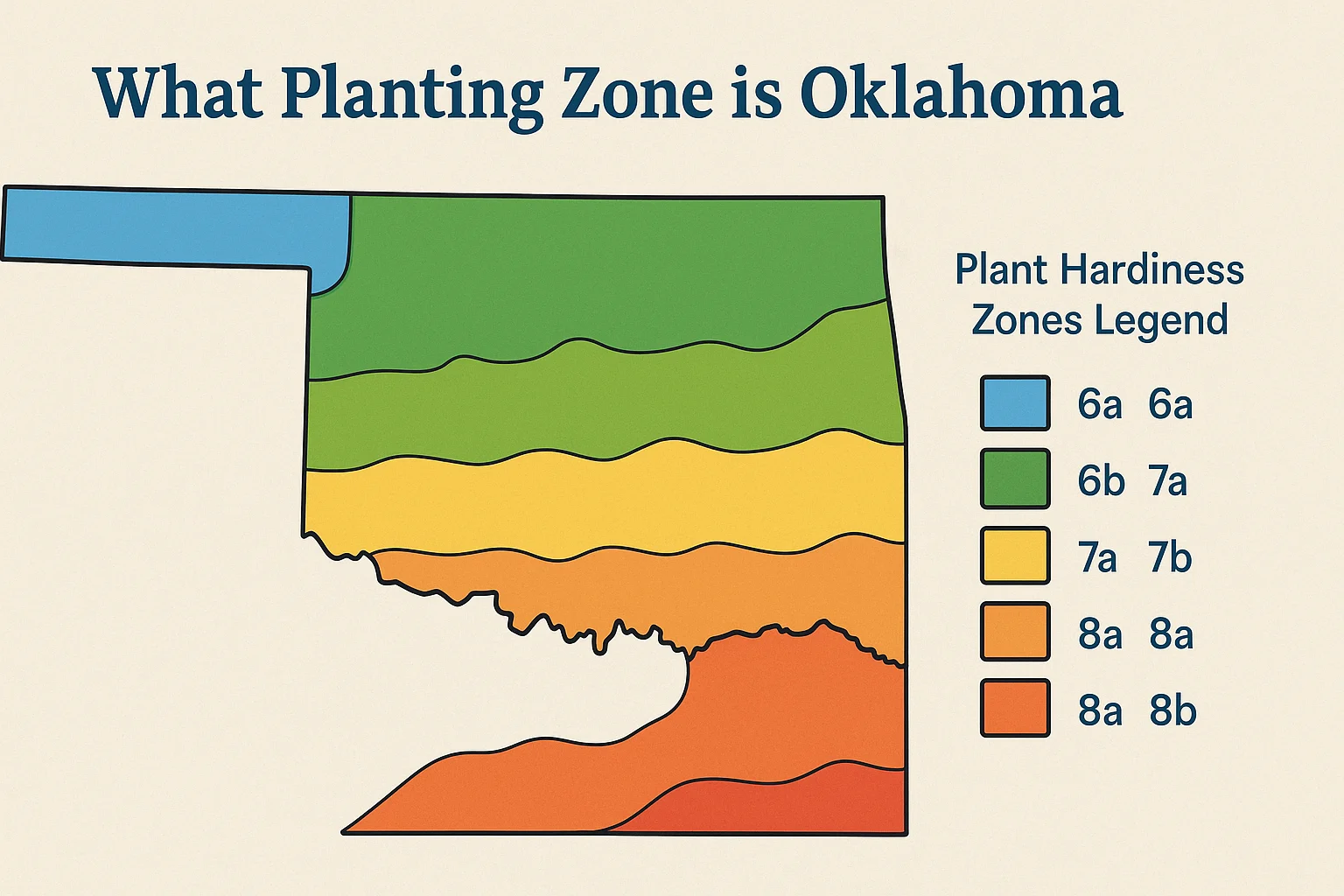What Planting Zone is Oklahoma?[Map, Cities, and Growing Tips]

Oklahoma’s planting zones range from 6a to 8a, with the majority of the state falling within zones 6b and 7a. Northern Oklahoma includes zones 6a and 6b, while central regions are predominantly 7a and 7b. Southern Oklahoma features zones 7b to 8a, providing longer growing seasons and milder winters.
If you’ve ever wondered what planting zone is Oklahoma, this guide will give you a detailed breakdown by city, region, and growing conditions to help you plan your garden confidently.
🌱 What Planting Zone is Oklahoma?
The official USDA Plant Hardiness Zones classify Oklahoma into zones 6a through 8a, based on average annual minimum winter temperatures.
| Region | USDA Zone |
|---|---|
| Northern Oklahoma (Enid, Ponca City) | Zone 6a–6b |
| Central Oklahoma (Oklahoma City, Norman) | Zone 7a–7b |
| Southern Oklahoma (Ardmore, Durant) | Zone 7b–8a |
This classification helps gardeners answer what planting zone is Oklahoma and choose plants suited to their local climate.
📍 Oklahoma Planting Zones by City
Here’s a city-wise breakdown to help you identify what planting zone is Oklahoma for your area:
| City | Planting Zone |
|---|---|
| Oklahoma City | Zone 7a |
| Tulsa | Zone 7a |
| Norman | Zone 7a |
| Lawton | Zone 7b |
| Enid | Zone 6b |
| Ardmore | Zone 7b |
| Ponca City | Zone 6b |
| Durant | Zone 8a |
| Stillwater | Zone 7a |
| Bartlesville | Zone 6b |
If you’re asking what planting zone is Oklahoma for your garden, your exact location can fine-tune your planting choices.
🌡️ Why Planting Zone in Oklahoma Matters?
Understanding what planting zone is Oklahoma helps you:
- Select perennials that survive Oklahoma winters
- Time your planting schedules accurately
- Avoid frost damage to sensitive plants
- Maximize vegetable yields with correct sowing dates
For instance, a fig tree suited for Zone 8a might not survive in northern Oklahoma’s Zone 6a without winter protection.
🧑🌾 How Oklahoma’s Planting Zones Affect Your Garden?
Here’s what you can expect across Oklahoma:
- Zone 6a–6b: Cold winters, shorter growing seasons; great for hardy vegetables and flowers.
- Zone 7a–7b: Milder winters, longer seasons; ideal for a wider variety of perennials and early crops.
- Zone 8a: Warmest region, allowing subtropical plants and extended growing windows.
By identifying what planting zone is Oklahoma for your area, you can make informed decisions about plant selection, timing, and care.
📅 Planting Calendar Based on Oklahoma Zones
| Plant Type | Zone 6b Start | Zone 7a Start | Zone 8a Start |
|---|---|---|---|
| Cool-Season Vegetables | Mid-March | Early March | Late February |
| Warm-Season Vegetables | Late April | Early April | Mid-March |
| Perennials & Shrubs | Early Spring/Fall | Spring/Fall | Fall preferred |
Knowing what planting zone is Oklahoma allows you to adapt this calendar to your needs.
🧠 Gardening Tips for Oklahoma’s Planting Zones
- Mulch heavily in Zone 6 to protect roots from freezing.
- Choose drought-tolerant plants for hot Oklahoma summers.
- Watch for late frosts in northern regions.
- In Zone 8a, take advantage of the long season for second plantings.
- Always check your local frost dates, even after knowing what planting zone is Oklahoma.
🗺️ Find Your Exact Planting Zone in Oklahoma
While city-level data is helpful, microclimates can vary. For precise info:
- Visit the official USDA Plant Hardiness Zone Map
- Enter your ZIP code to see exactly what planting zone is Oklahoma for your garden.
🧮 Helpful Calculators for Oklahoma Gardeners
- Soil Volume Calculator – Know exactly how much soil you need for raised beds.
- Plant Spacing Calculator – Prevent overcrowding and maximize yield.
- Indoor Plant Watering Calculator – Perfect for your houseplants or container garden.
🙋 Frequently Asked Questions
What planting zone is Oklahoma City?
Oklahoma City is in USDA Zone 7a, with average minimum winter temperatures between 0°F to 5°F.
What planting zone is Tulsa, Oklahoma?
Tulsa also falls in Zone 7a, offering a long growing season suitable for vegetables, fruits, and perennials.
What planting zone is southern Oklahoma?
Southern Oklahoma, including areas like Durant and Ardmore, is in Zones 7b to 8a, featuring milder winters and extended planting windows.
